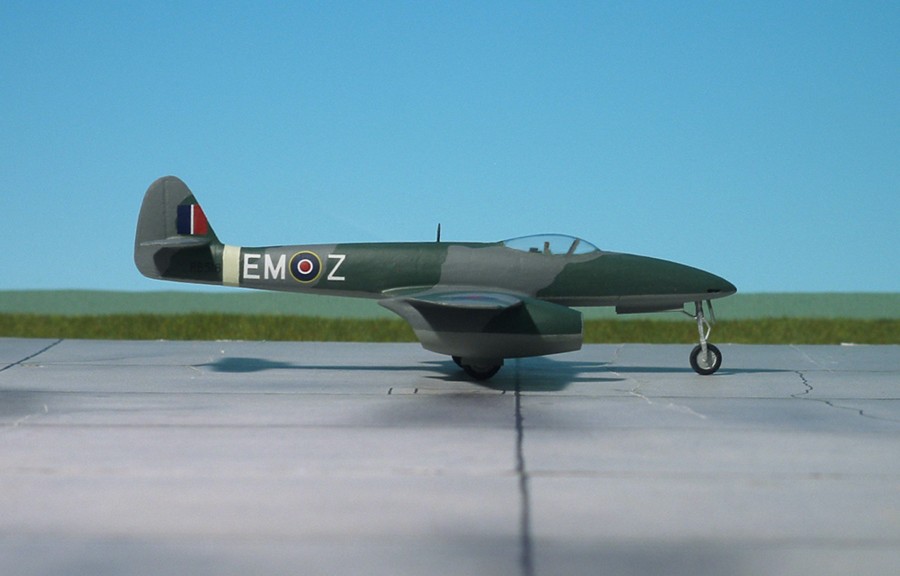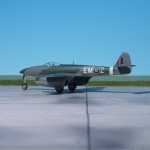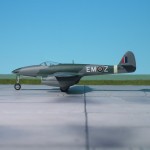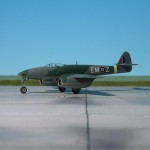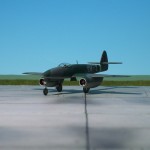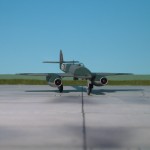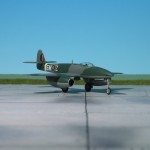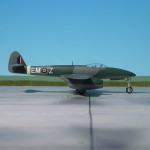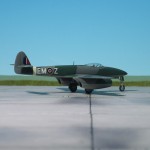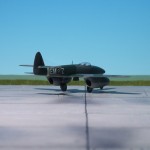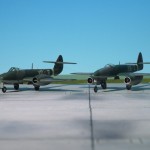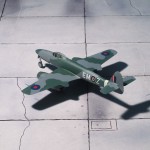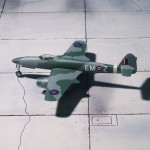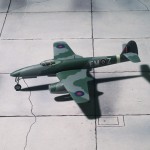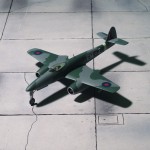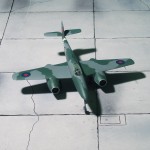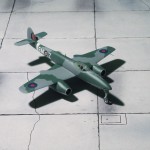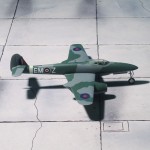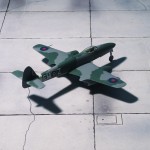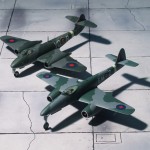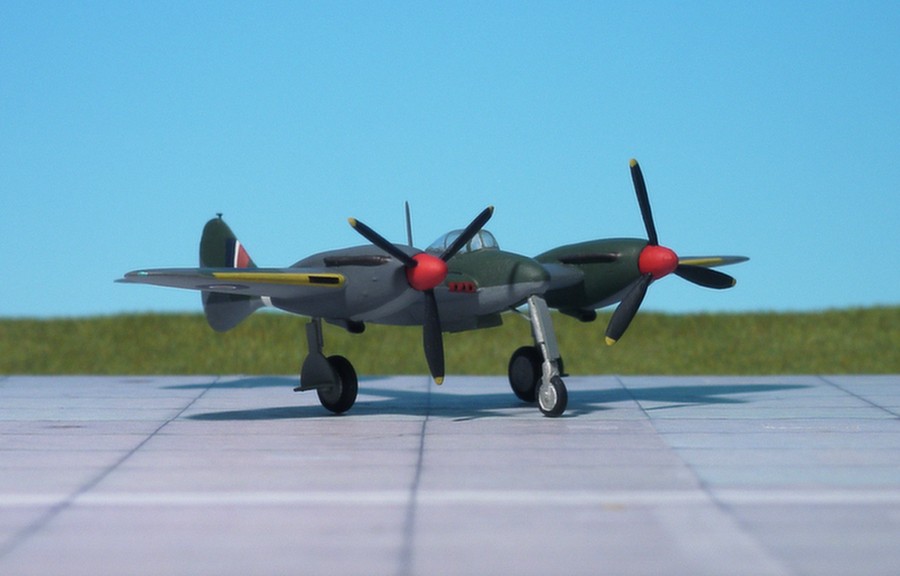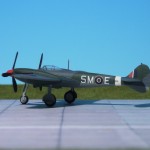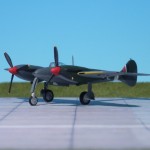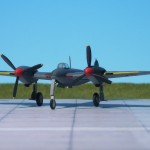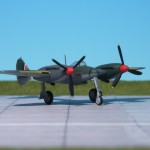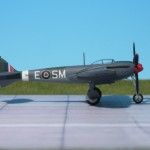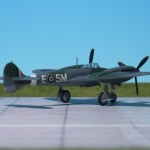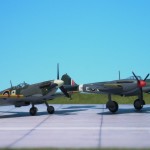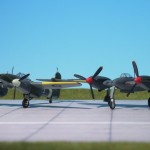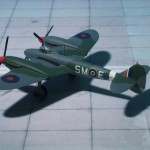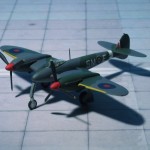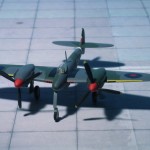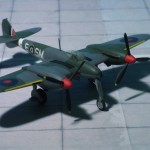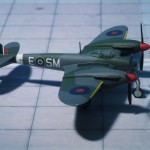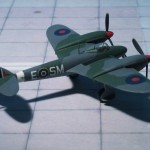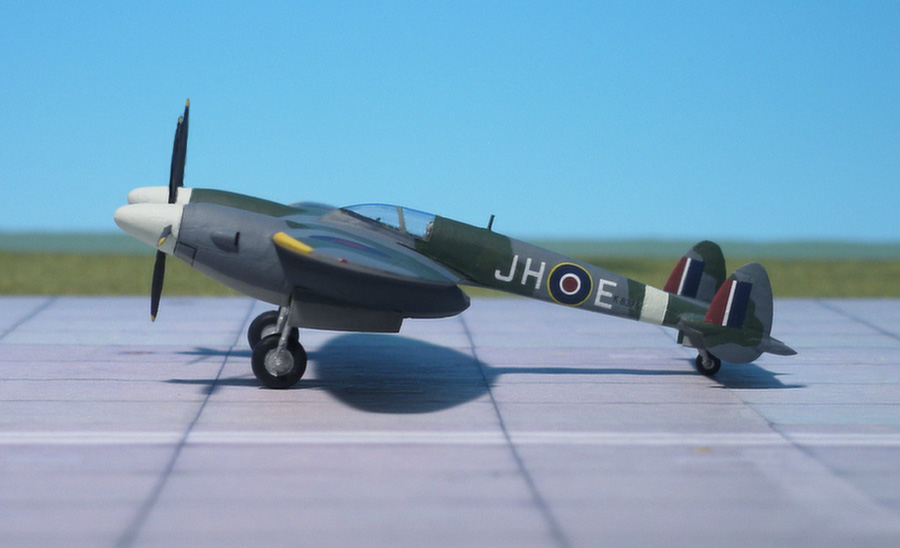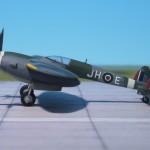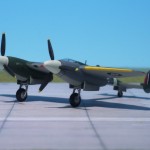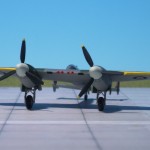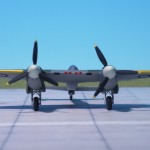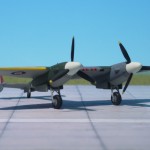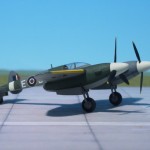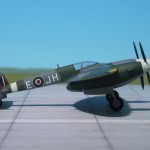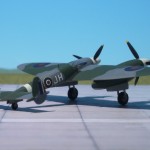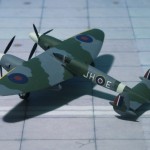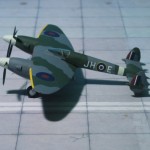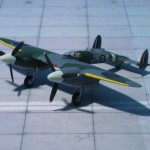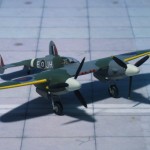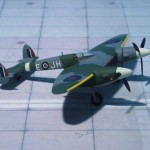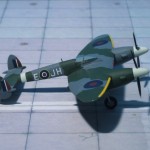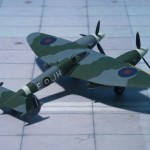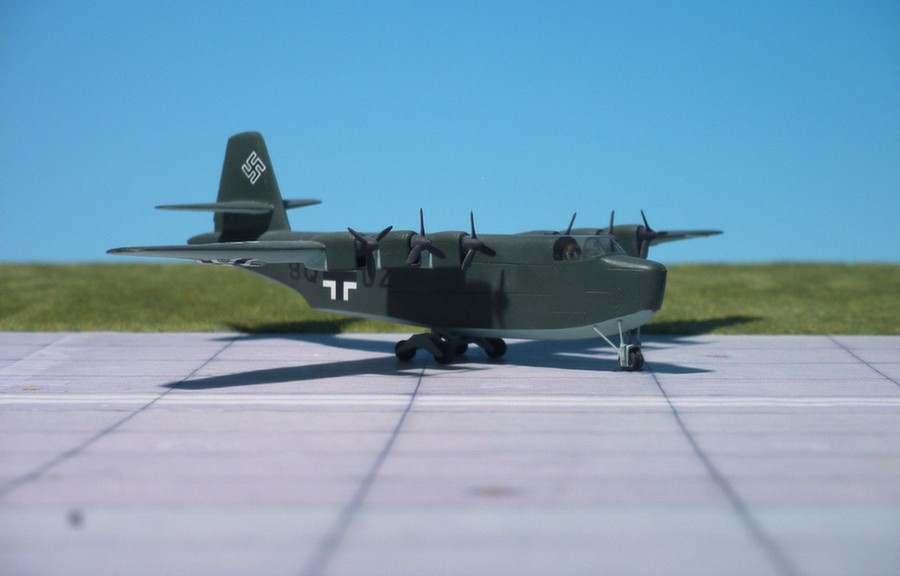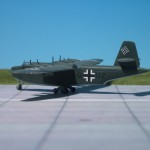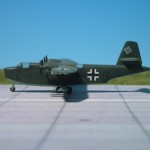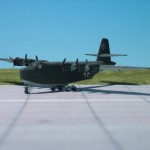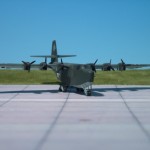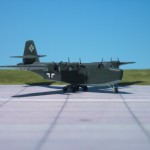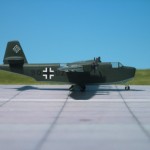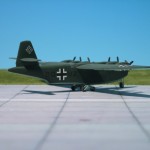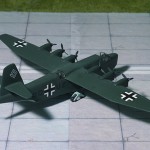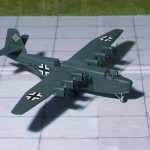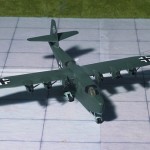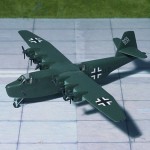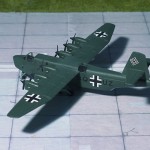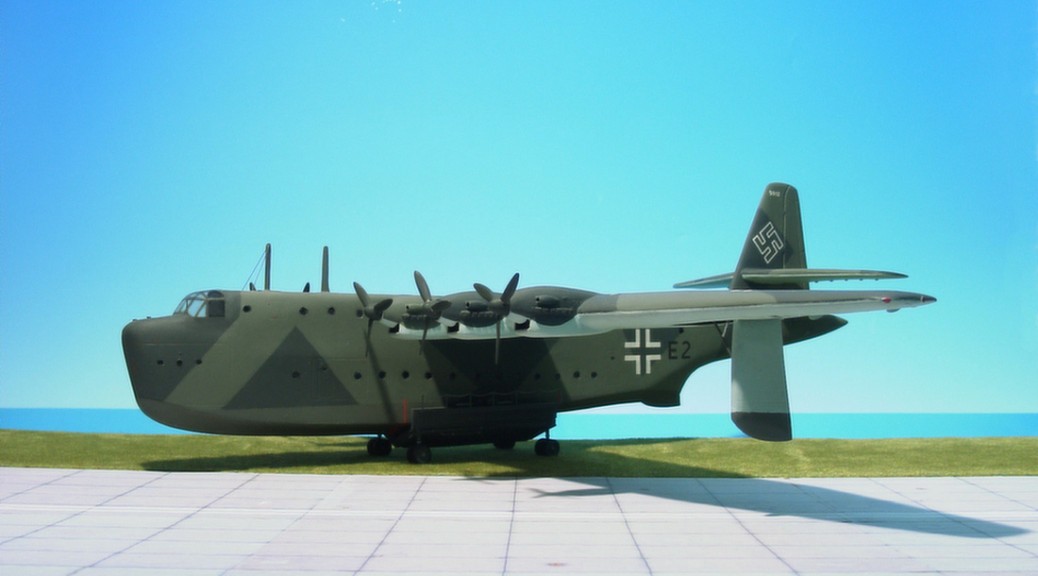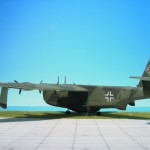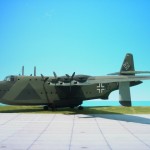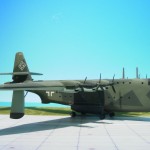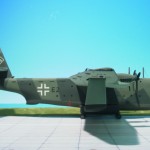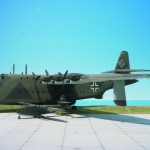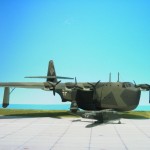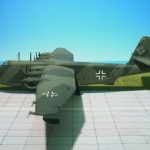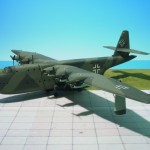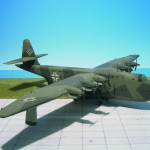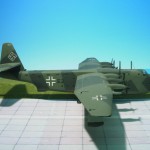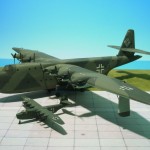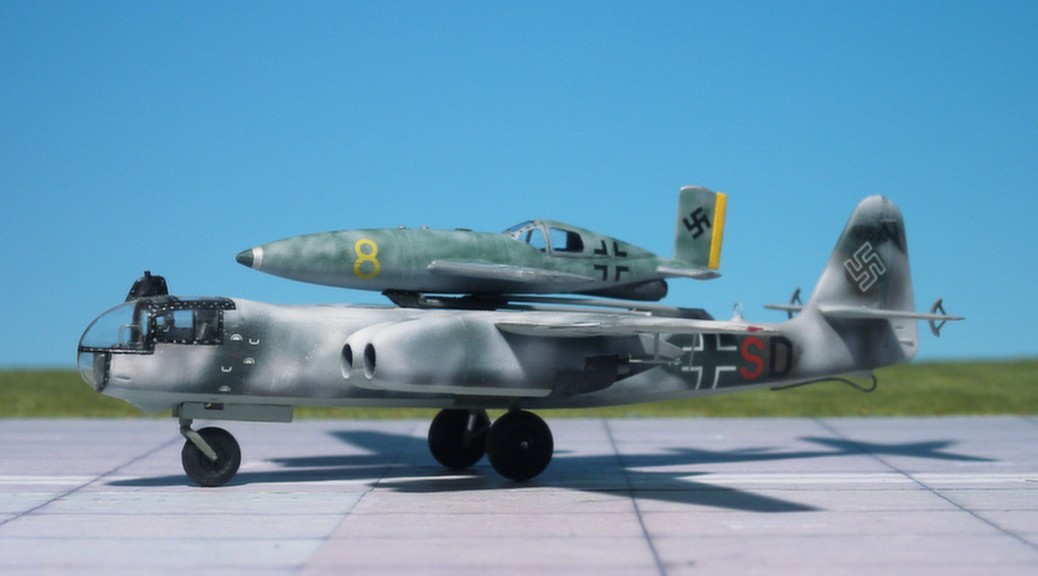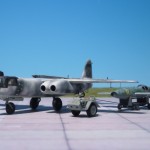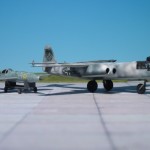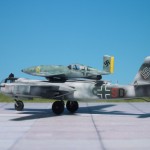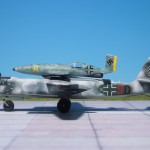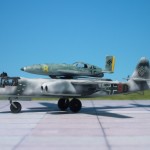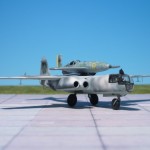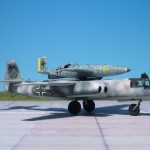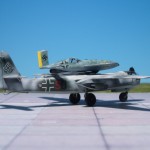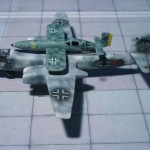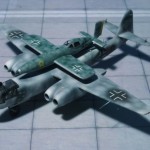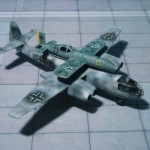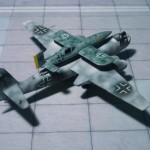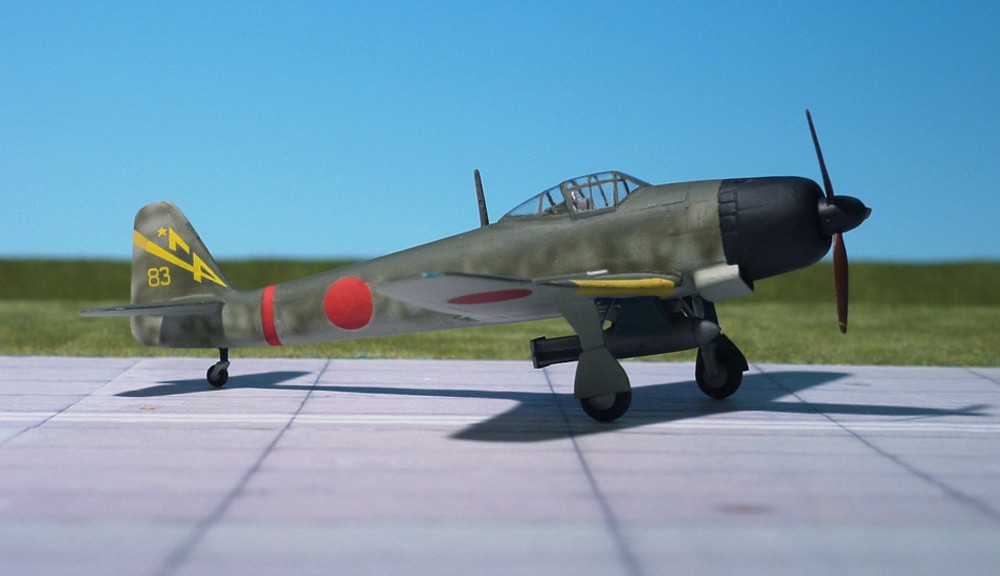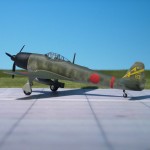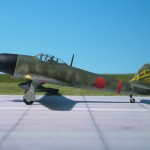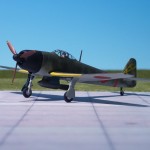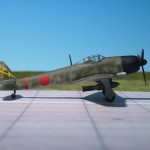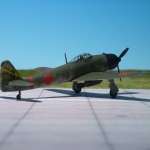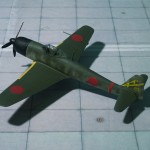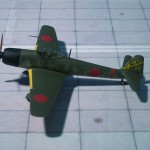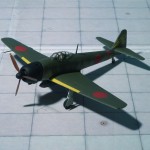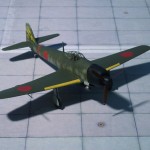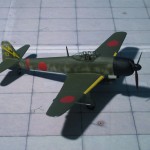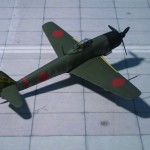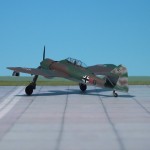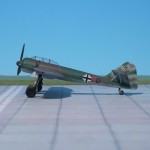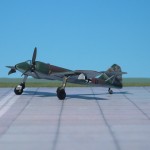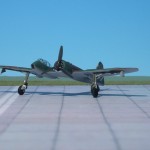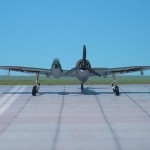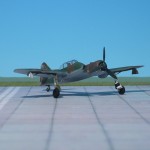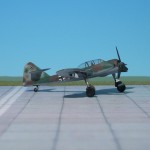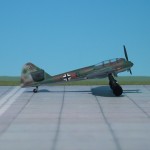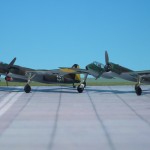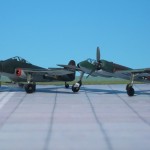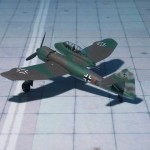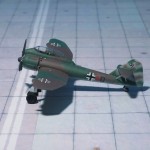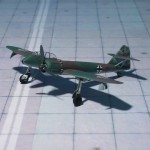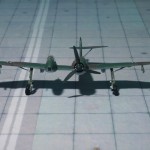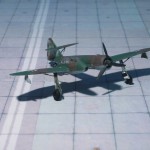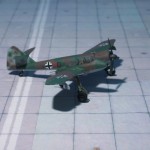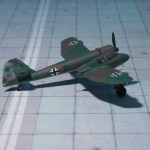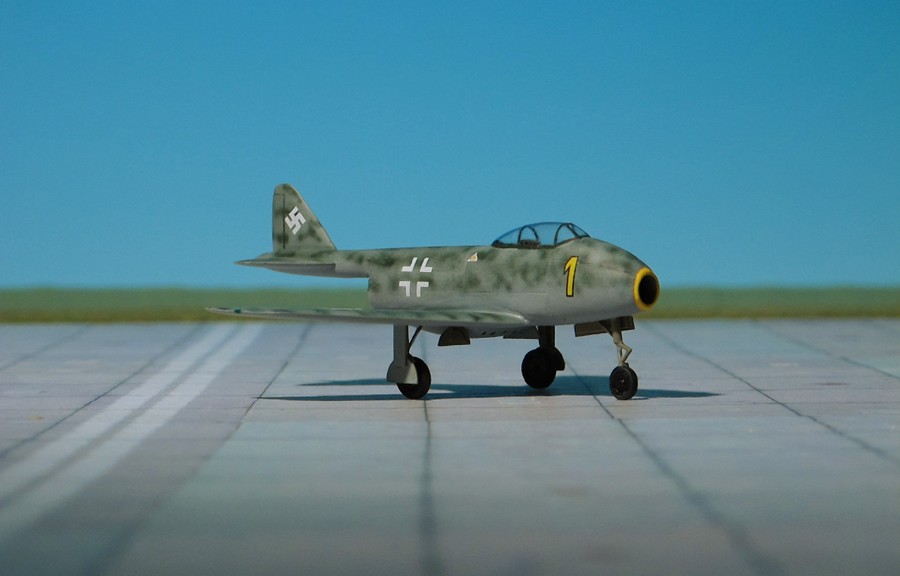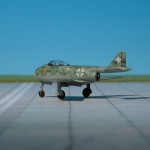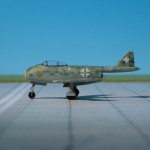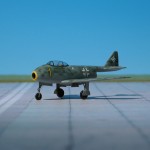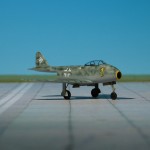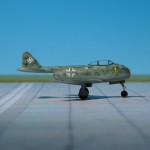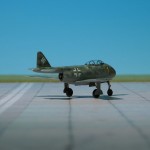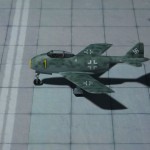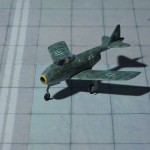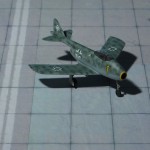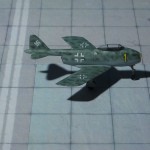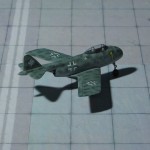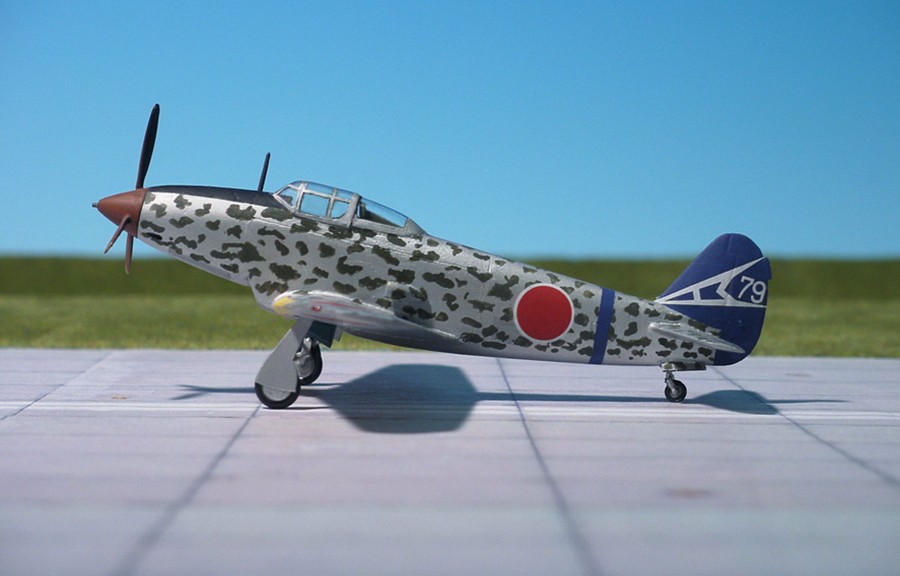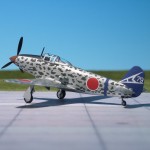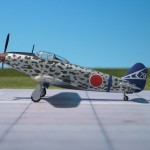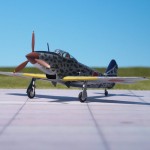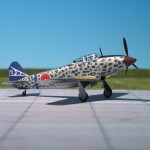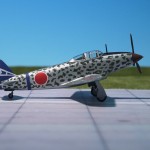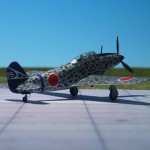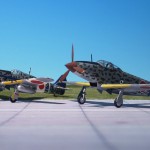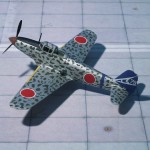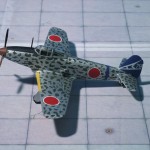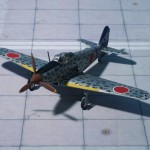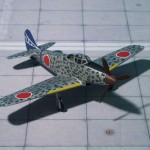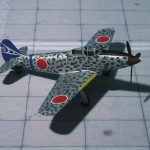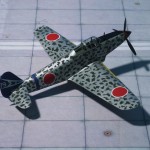Type: Two Turbojets Single Seat Fighter Project
Competitor to the Gloster Meteor
Supermarine Type 327 “Spito” (Unicraft, Resin)
TYPE: Fighter
ACCOMMODATION: Pilot only
POWER PLANT: Two Rolls-Royce Merlin liquid-cooled engines, rated at 1,240 hp each
PERFORMANCE: 450 mph at 15.000 ft
COMMENT: The Supermarine Type 324 and Type 325 were British two-engined fighter designs proposed as the replacement for the Supermarine Spitfire and Hawker Hurrican. Neither of them nor a revised design – the Type 327 – to carry cannon was accepted for development and production.
As an aircraft to succeed the Hurricane and Spitfire then entering service, Air Ministry specification F.18/37 required a 400+ mph (at 15,000 ft) fighter with twelve .303 inch machine gun armament.
Hawker Aircraft submitted a single seat, single engine design with two possible engines, the Hawker Typhoon powered by the Rolls-Royce Vulture and the Hawker Typhoon, with Napier Sabre engine.
Gloster submitted two similar twin-boom designs with 12 Browning machine guns in the nose and a pusher Napier Sabre engine as well as an adaptation of their proposal to F.9/37 with nose-mounted armament.
Bristol’s design was one airframe offered with three alternative engines.
In 1938 Supermarine submitted brochures describing the Type 324 (under the company specification No.458) along with the Type 325. Both were compact twin-engine designs – one tractor and one pusher – with either Rolls-Royce Merlin or Bristol Taurus engines.
Hawker’s designs – which Sydney Camm had been working on since April 1937 – were accepted and prototypes of each ordered.
The Type 324 was a low-wing, twin-engined monoplane featuring the elliptical wing shape of the Spitfire, with retractable tricycle undercarriage.
Twin engines were expected to give a maximum speed of 450 mph. In addition, the twin layout gave the usual advantages of torque cancellation, improved pilot view, tricycle landing gear, performance, improved take-off performance and allowed the use of the proven Rolls-Royce Merlin engine.
The structure of the aircraft was Alclad aluminium alloy. The wing was designed in sections, so that alternative engines (Bristol Taurus) or armament could be accommodated. Fowler flaps were fitted for take-off/landing. Spoiler flaps were fitted to improve performance.
A number of armament types were considered. The main was 12 Browning in two packs of six in each wing outer section; these could be removed complete with ammunition to allow rapid rearming and servicing of the weapons.
When the Air Ministry felt progress on the Westland Whirlwind cannon-armed fighter was too slow, they asked for the F.18/37 tenders to be revised with 20mm cannon armament. Supermarine dropped the pusher design and proposed a six-cannon fighter as the Type 327 Spito. The Ministry did not feel its advantages outweighed other considerations, and that the Whirlwind – or the adaption oft he Bristol Beaufort – would enter service before Supermarine’s design could (Ref.: 24).
Miles M.22 (Unicraft, Resin)
Blohm & Voss FGP 227 (Anigrand, Resin)
TYPE: Research Flying boat
ACCOMMODATION: Crew of two
POWER PLANT: Six ILO F 12/400 air-cooled engines, rated at 21.1 hp each
PERFORMANCE: No data available
COMMENT: The FGP 227 was a scale flying model of the Blohm & Voss Bv 238 flying boat, built to provide data for the development of the Bv 238.
The proposed Blohm & Voss Bv 238 flying boat was to have an advanced hull design which had never been tried before. The Czech Flugtechnische Fertigungsgemeinschaft Prag (FGP) was engaged to build a quarter-scale test aircraft.
The FGP 227 was a faithful, approximately quarter-scale model of the proposed design, having a long, narrow hull with a high-mounted wing and conventional tail. The pilot sat in a front cockpit and the flight test observer in another one aft of the wing. Power was supplied by six 21 hp ILO F 12/400 air-cooled two-stroke engines driving three bladed propellers, mounted along the wings.The model was completed early in 1944, registered as BQ+UZ and fitted with a temporary wheeled undercarriage of ten small wheels fitted with low-pressure tyres.
Intended to allow flight tests to commence from the manufacturers airfield, the FGP 227 refused to take-off from the grass airfield. The aircraft was dismantled and transported to Erprobungsstelle See, Travemünde (E-Stelle – flying boat testing station). During transport French prisoners of war loading the wing onto flat-bed trucks allowed it to fall from a crane causing damage which was not repaired until September 1944.
Flight tests commenced in September 1944 as soon as the repairs were completed, but all six engines stopped due to fuel starvation soon after take-off, resulting in a heavy landing on the water. The FGP 227 was again repaired after which the aircraft flew several more times. By this time construction and testing of the Bv 238 had started, so no useful data was gleaned from the programme (Ref.:24).
Blohm & Voss Bv 238 V1, (Airmodel, Vacu)
TYPE: Long-range Transport, Maritime Patrol and Bomber Flying Boat
ACCOMMODATION: Crew of 12
POWER PLANT: Six Daimler-Benz DB 603D liquid-cooled engines, rated at 1,900 hp each
PERFORMANCE: 264 mph at 60,000 kg at 20,000 ft
COMMENT: The Blohm & Voss BV 238 was a German flying boat, built during World War II. It was the heaviest aircraft ever built when it first flew in 1944, and was the largest aircraft produced by any of the Axis powers during World War II.
Development of the BV 238 giant flying boat began in 1941, following the success of the smaller but still enormous Blohm & Voss Bv 222 Wiking.
An approximately quarter-scale model of the Bv 238 was commissioned to test the new, long and slim hull design. Built by the Flugtechnische Fertigungsgemeinschaft GmbH in Prag (FGP), the FGP 227 arrived too late to contribute any data to the program.
Although extensive defensive armament was planned the first prototype, the Bv 238 V1, had none. It began flight trials in April 1944 but was strafed and partially sunk while moored on Lake Schaal, some miles to the east of Hamburg. One wing remained above water and it was salvaged, but by this time the war had ended and the Allies refused to let it be restored so it was taken out to deeper water and sunk.
The Bv 238 was an extremely large flying boat of conventional aerodynamic design, but bearing the usual B&V structural hallmarks of all-metal construction with a tubular steel wing main spar which also acted as the armoured main fuel tank. Of the era, only the earlier soviet Tupölev ANT-20, the americam Martin XPB2M-1 and the later Hughes H-4 Hercules had a bigger wing span. However it would be the heaviest yet flown, at 100 tonnes fully loaded.
The hull had an unusually long and slim planing bottom, of essentially two-step design but with a row of smaller auxiliary steps behind the main one. A large nose door opened onto its cavernous interior, with the main crew cabin immediately above and behind it.
The wing was of straight, constant-chord form with tapered outer sections. Auxiliary floats were integrated into underside panels of the outer sections and could be retracted to lie flush with the wing. A catwalk ran internally along the wing in front of the tubular steel main spar, providing access to the engines in flight.
Power was provided by six 1,750 hp Daimler-Benz DB 603 liquid-cooled inverted V12 piston engines, arranged in nacelles along the leading edge of the centre section.
A landplane version, initially called the Bv 238-Land, was proposed, capable of carrying out transport, long-range bombing and transatlantic reconnaissance duties. The lower hull was replaced by a plain fairing with retractable undercarriage comprising twelve main and two nose wheels. One bomb bay filled the space between the wheel bays, another lay behind the main undercarriage. The wing floats were similarly replaced with retractable outrigger stabilising wheels. The nose wheel could be folded up, making the aircraft “kneel” and allowing vehicles to drive directly on- and off-board via a loading ramp to the nose doorway. Alternatively, passenger seating could be fitted. A further, upper deck behind the crew cockpit accommodated further passengers, bringing the total capacity to 300 troops.
Renamed the Blohm & Voss Bv 250 in 1942, three prototypes were ordered but none were finished by the end of the war (Ref.: 24).
Arado Ar 234C-2 (Dragon) with Focke-Wulf “Rammer” (Unicraft, Resin)
Kawasaki Ki-119 (Unicraft, Resin)
TYPE: Light bomber. Project
ACCOMMODATION: Pilot only
POWER PLANT: Mitsubishi Ha-104 radial engine, rated at 1,900 hp
PERFORMANCE: 360 mph at 19,685 ft
COMMENT: The Kawasaki Ki-119 was a design for a single-engine light bomber that would have been used in the defense of the Japanese homeland. Earlier Japanese bombers had been designed to operate over long distances, either in China or over the Pacific, but by the start of 1945 it was clear that the Japanese army might soon be fighting on home soil. This meant that a short range single-engine bomber would be possible, saving on the limited supply of both engines and trained air crew.
In March 1945 the Army Air Force issued Kawasaki with orders to produce a single seat bomber that could carry 1,764lb of bombs to targets 373 miles from its base, armed with two 20mm cannon and powered by one 1,900 hp Army Type 4 radial engine. Unlike many new aircraft being developed in Japan in 1945 the Ki-119 was not designed to be used in suicide attacks.
Takeo Doi and his team produced a design and a mock-up in three months. The fuselage was based on that of the Kawasaki Ki 100 radial-engine fighter. The aircraft was made as easy to fly as possible – a wide track undercarriage with good shock absorbers was chose to make the aircraft easy to handle on the ground, and large wings with a high aspect-ratio were designed, to make it easy to handle in the air. The aircraft was designed to carry three different sets of armament. In its basic light bomber role it was to be armed with two 20mm cannon and one 1,764lb bomb. It could also serve as a fighter escort, with no bombers but two extra 20mm cannons, or as a dive bomber with two 551lb bombs.
The impressively rapid development of the Ki-119 came to a halt in June 1945 when the detailed drawings were destroyed when American air raids damaged Kawasaki’s factory at Kagamigahara. This pushed back the expected delivery date for the prototype from September until November, with production expected in time for the new aircraft to take part in the fighting of 1946. The unexpectedly sudden end to the war meant that the prototype was never completed (Ref.: 24).
Blohm & Voss Bv. 237 (Unicraft, Resin)
TYPE: Dive bomber, ground attack fighter. Project
ACCOMMODATION: Pilot only
POWER PLANT: One BMW 801D radial engine, rated at 1,700 hp
PERFORMANCE: 360 mph
COMMENT: The Blohm & Voss Bv 237 was a proposed dive bomber with an unusual asymmetric design based on the Blohm & Voss Bv 141, as well as other projects like Bv P.194 and Bv P.204. In 1942 the Luftwaffe was interested in replacing the venerable but ageing Junkers Ju 87, and Dr. Richard Vogt’s design team at Blohm & Voss began work on project P 177. The dive bomber version would have had a one man crew and was heavily armed with cannon, machine gun and bombs. A two seat ground attack version was also proposed. A final B-1 type was to incorporate a Junkers Jumo 004B turbojet engine in a third nacelle slung underneath the wing, between the piston engine and the cockpit. In early 1943 a production order was issued for the P 177 now called the Bv 237. In the summer that year the RLM ordered all developmental work stopped. Work continued later and it was determined that construction could begin in mid 1945, but plans for a pre-production A-0 series were abandoned, leaving the project at the pre-production stage near the end of 1944, with only a wooden mock-up completed (Ref.: 23).
Blohm & Voss Bv P.211.01 (Unicraft, Resin)
TYPE: Interceptor fighter. Project
ACCOMMODATION: Pilot only
POWER PLANT: BMW 003A-1 turbojet, rated at 800 kp
PERFORMANCE: 536 mph at 26,250 ft (estimated)
COMMENT: Design of an interceptor fighter from mid 1944, forerunner of the Bv P.211.02, that was submitted for the “Volksjäger” (Peoples fighter) competition. Winner was the Heinkel He 162 “Spatz”.
Kawasaki Ki-88 (Unicraft, Resin)
TYPE: Fighter, fighter bomber
ACCOMMODATION: Pilot only
POWER PLANT: One Kawasaki Ha-140 liquid-cooled engine, rated at 1,500 hp
PERFORMANCE: 373 mph at 19,685 ft
COMMENT: The Kawasaki Ki 88 was designed as a fighter aircraft and inspired by the Bell P-39 Airacobra. Work on the design began in 1942 and by 1943 a full-scale mock-up was completed. The engine was mounted behind the cockpit, driving a tractor propeller via an extension shaft. Proposed armament comprised a 37 mm cannon in the propeller shaft and two 20 mm cannon in the lower section of the nose. Calculation suggested no great improvement on that of the Kawasaki Ki-61 Hien already in production, and so the project was abandoned during 1943 (Ref.: 1).
